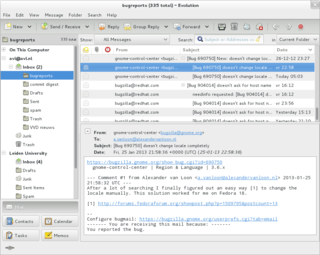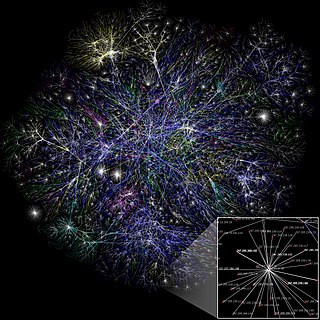
Email is a method of transmitting and receiving messages using electronic devices. It was conceived in the late–20th century as the digital version of, or counterpart to, mail. Email is a ubiquitous and very widely used communication medium; in current use, an email address is often treated as a basic and necessary part of many processes in business, commerce, government, education, entertainment, and other spheres of daily life in most countries.
Telecommunications had an early beginning in Mauritius, with the first telephone line installed in 1883, seven years after the invention of the telephone. Over the years, the network and telephony improved. By the late 20th century, the rapid development and convergence of information and telecommunications technologies gave rise to an ICT industry on the island along with many incentives provided by the government. The government thus aims to make the ICT sector the 5th pillar of the Mauritian economy and Mauritius a Cyber Island. Historically, the country is known for tourism, rather than its call centers and business process outsourcing.
Telecommunications in Tanzania include radio, television, fixed and mobile telephones, and the Internet available in mainland Tanzania and the semiautonomous Zanzibar archipelago.
Telecommunications in Trinidad and Tobago include radio, television, fixed and mobile telephones, and the Internet.
Telecommunications in Albania include radio, television, fixed and mobile telephones, and the Internet.

An open mail relay is a Simple Mail Transfer Protocol (SMTP) server configured in such a way that it allows anyone on the Internet to send e-mail through it, not just mail destined to or originating from known users. This used to be the default configuration in many mail servers; indeed, it was the way the Internet was initially set up, but open mail relays have become unpopular because of their exploitation by spammers and worms. Many relays were closed, or were placed on blacklists by other servers.
A web portal is a specially designed website that brings information from diverse sources, like emails, online forums and search engines, together in a uniform way. Usually, each information source gets its dedicated area on the page for displaying information ; often, the user can configure which ones to display. Variants of portals include mashups and intranet dashboards for executives and managers. The extent to which content is displayed in a "uniform way" may depend on the intended user and the intended purpose, as well as the diversity of the content. Very often design emphasis is on a certain "metaphor" for configuring and customizing the presentation of the content and the chosen implementation framework or code libraries. In addition, the role of the user in an organization may determine which content can be added to the portal or deleted from the portal configuration.

Wireless community networks or wireless community projects or simply community networks, are non-centralized, self-managed and collaborative networks organized in a grassroots fashion by communities, non-governmental organizations and cooperatives in order to provide a viable alternative to municipal wireless networks for consumers.
The domain com is a top-level domain (TLD) in the Domain Name System (DNS) of the Internet. Created in the first group of Internet domains in March of 1985, its name is derived from the word commercial, indicating its original intended purpose for subdomains registered by commercial organizations. Later, the domain opened for general purposes.

The Crown Commercial Service (CCS) is an executive agency and trading fund of the Cabinet Office of the UK Government. The CCS is responsible for managing the procurement of common goods and services, increasing savings for the taxpayer by centralising buying requirements, and leading on procurement policy on behalf of the government.
Email authentication, or validation, is a collection of techniques aimed at providing verifiable information about the origin of email messages by validating the domain ownership of any message transfer agents (MTA) who participated in transferring and possibly modifying a message.

A computer network is a set of computers sharing resources located on or provided by network nodes. Computers use common communication protocols over digital interconnections to communicate with each other. These interconnections are made up of telecommunication network technologies based on physically wired, optical, and wireless radio-frequency methods that may be arranged in a variety of network topologies.
An SMS gateway or MMS gateway allows a computer to send or receive text messages in the form of Short Message Service (SMS) or Multimedia Messaging Service (MMS) transmissions between local and/or international telecommunications networks. In most cases, SMS and MMS are eventually routed to a mobile phone through a wireless carrier. SMS gateways are commonly used as a method for person-to-person to device-to-person communications. Many SMS gateways support content and media conversions from email, push, voice, and other formats.
NHSmail is an email, diary and directory system for National Health Service (NHS) employees in England and Scotland. The system is not for patients of the NHS. Retired NHS staff do not have access.
Opportunistic TLS refers to extensions in plain text communication protocols, which offer a way to upgrade a plain text connection to an encrypted connection instead of using a separate port for encrypted communication. Several protocols use a command named "STARTTLS" for this purpose. It is a form of opportunistic encryption and is primarily intended as a countermeasure to passive monitoring.

Belkin International, Inc., is an American consumer electronics company headquartered in El Segundo, California. It produces mobile and computer connectivity devices and peripherals for consumer and commercial use. These include wireless chargers, power banks, charging cables, data cables, audio and video adapters, headphones, earbuds, screen protectors and cases, surge protectors, docking stations and data hubs, secure KVM switches and network cables.
Telecommunications in Cyprus includes radio, television, fixed and mobile telephones, and the Internet, in the Republic of Cyprus.

A national broadband plan is a national plan to deploy broadband Internet access. Broadband is a term normally considered to be synonymous with a high-speed connection to the internet. Suitability for certain applications, or technically a certain quality of service, is often assumed. For instance, low round trip delay would normally be assumed to be well under 150ms and suitable for Voice over IP, online gaming, financial trading especially arbitrage, virtual private networks and other latency-sensitive applications. This would rule out satellite Internet as inherently high-latency. In some applications, utility-grade reliability or security are often also assumed or defined as requirements. There is no single definition of broadband and official plans may refer to any or none of these criteria.
The Public Services Network (PSN) is a UK government's high-performance network, which helps public sector organisations work together, reduce duplication and share resources. It unified the provision of network infrastructure across the United Kingdom public sector into an interconnected "network of networks" to increase efficiency and reduce overall public expenditure. It is now a legacy network and public sector organisations are being migrated to using services on the public internet.
The Health and Social Care Network (HSCN) is a standards-based network that replaced the N3 network in the National Health Service (NHS) in England. It went live in April 2017. Transition to the new network was completed by November 2020.






